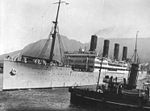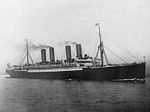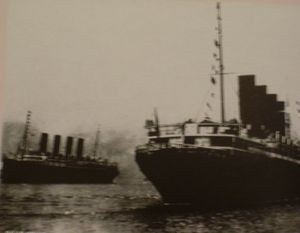Four funnel liner
A four funnel liner, four funneled liner or four stacker is an ocean liner with four funnels. The SS Great Eastern, launched on the 31st of January 1858 (a full 40 years ahead of its contemporaries) became the only ocean liner to ever sport five funnels, as one funnel was later removed,[1] so the Great Eastern also by de facto become the first ocean liner to sport four funnels. The SS Kaiser Wilhelm der Grosse, christened May 4, 1897, was the next ocean liner to sport four funnels and was one of the first of the golden era of ocean liners that become prominent in the early 20th century.[2] The most famous four funnel liners are the RMS Titanic which sunk after striking an iceberg on her maiden voyage and the RMS Lusitania which was torpedoed during World War One.
In all, fifteen four funnel liners were ever built (5 were owned by Germany, 9 by British, and 1 by France), the Great Eastern in 1858 and the remaining fourteen all between 1897 and 1922. Four of these sunk during the World Wars, and apart from the Titanic, the remaining were scrapped.[3] RMS Mauretania was the fastest of all four funnel liners. The last four funnel liner ever built was the SS Windsor Castle but her two funnels were removed making RMS Aquitania the last four funnel liner in service, the Aquitania was the largest of all the four funnel liners and the only one to survive through both World Wars.
Contents
List of four funnel liners
| Picture | Liner[a] | Owner | Launched | Fate |
|---|---|---|---|---|
| 150px | RMS Aquitania[3] | Cunard Line | 21 April 1913 | scrapped 1950 |
 |
SS Arundel Castle[b][3] | Union-Castle Line | 11 September 1919 | scrapped 1959 |
| 150px | HMHS Britannic[c][d][3] | White Star Line | 26 February 1914 | sunk 21 November 1916 |
| 150px | SS Deutschland[3] | Hamburg-Amerika Line | 1900 | scrapped 1925 |
| 150px | SS France[3] | Compagnie Générale Transatlantique | 1910 | scrapped 1935 |
| 150px | SS Great Eastern[e][1] | Great Ship Company | 31 January 1858 | scrapped 1889–90 |
| 150px | SS Kaiser Wilhelm II[f][3] | North German Lloyd Line | 12 August 1902 | scrapped 1940 |
 |
SS Kaiser Wilhelm der Grosse[f][3] | North German Lloyd Line | 4 May 1897 | sunk 6 August 1914 |
| 150px | SS Kronprinz Wilhelm[f][3] | North German Lloyd Line | 30 March 1901 | scrapped 1923 |
| 150px | SS Kronprinzessin Cecilie[f][3] | North German Lloyd Line | 1 December 1906 | scrapped 1940 |
| 150px | RMS Lusitania[3] | Cunard Line | 7 June 1906 | sank 7 May 1915 |
| 150px | RMS Mauretania[3] | Cunard Line | 20 September 1906 | scrapped 1935 |
| 150px | RMS Olympic[d][3] | White Star Line | 20 October 1910 | scrapped 1935–37 |
| 150px | RMS Titanic[d][3] | White Star Line | 31 May 1911 | sank 15 April 1912 |
 |
SS Windsor Castle[b][3] | Union-Castle Line | 9 March 1921 | sunk 23 March 1943 |
Notes:
[a] SS denotes Steamship, RMS denotes Royal Mail Ship, HMHS denotes His/Her Majesty's Hospital Ship
[b] Originally constructed with four funnels, two were removed during later modernization.[3]
[c] The Britannic was originally called Gigantic but she was renamed after the Titanic's tragedy.[4]
[d] The last funnels on the White Star trio Olympic-class were dummies.[5]
[e] Originally constructed with five funnels, her No. 4 funnel was later removed after she was sold for cable laying[1]
[f] The group Kaiser-class[2] four funnel liners owned by North German Lloyd Lines were called the Four Flyers.[6]
Other four funnel passenger ships
City of Dublin Steam Packet Company
These four sister ships were unusual in having four funnels owned by City of Dublin Steam Packet Company, the Ulster, Munster, Leinster, and Connaught were all built to have high speed and to be far ahead of anything afloat at the time. These four ships all had the same design, 1700 gross tons, 337 ft long, and had two-cylinder oscillating engines of about 750 nhp, and had four powerful paddle steamers. The last of the quartet, Connaught, was the first steamer to exceed 18 knots in the world.[7]
- RMS Connaught (1) (1860)
- RMS Leinster (1) (1860)
- RMS Munster (1) (1860)
- RMS Ulster (1) (1860)
Isle of Man Steam Packet Company
- Ben-my-Chree (2) (1875) - a four funnel paddle liner owned by Isle of Man Steam Packet Company.[8]
Purpose of four funnels
The primary purpose of funnels on steamships were to allow smoke, heat and excess steam to escape from the boiler rooms. As liners became larger, more engines were used. The number of funnels became symbolic of speed and safety[2], so shipping companies sometimes added false funnels (like the one sported by the Olympic-class) to give an impression of power.[9] Additionally, in the event of a ship foundering, ladders inside the funnels provided escape routes for the stokers and engineers once the watertight doors were closed.
The trend of competing shipping lines building four funnel liners encompassed a very short time span ranging from the SS Kaiser Wilhelm der Grosse in 1897 to the SS Windsor Castle in 1922. As for the number of funnels in some cases the reason for sporting four was a matter of necessity in other cases it was more symbolic. The Cunard Line record holders Lusitania and Mauretania were both laid out with four boiler rooms with one funnel to each room, other slower ships such as the Olympic, Titanic and Britannic only had three boiler rooms and three operational funnels. However sporting four funnels represented power, safety and prestiege, in keeping with the style and fashion of the early 20th century the White Star Line opted to fit the Olympic Trio with 'dummy' fourth funnels in order to portray them to the public as complete rivals to the Cunard duo. The ideology of four funnels representing size and power rapidly diminished soon after World War One, later larger flagships including the SS Imperator, SS Normandie and the RMS Queen Mary all sported three funnels to conserve deck space, later still as shipbuilding became more efficient the RMS Queen Elizabeth, RMS Mauretania (II) and the SS America reduced this further down to two funnels, today's modern cruise ships are all built with only a single funnel and many military vessels no longer sport them at all.
Unfinished four-funnel liners
In the late 1920's the worlds main shipping lines were Britain's Cunard Line and White Star Line and France's Compagnie Générale Transatlantique. Each of these three were operating aging vessels and required new larger and more modern 1000ft long superliners to remain competitive. CGT began construction of the SS Normandie while Cunard placed an order for the RMS Queen Mary. The weakest company of the three White Star placed an order to their shipbuilders Harland and Wolff for the Oceanic III, a successor to the lines inaugural liner, the RMS Oceanic of 1870. The exact intended design of the Oceanic III is unknown, although company concept renderings show it to be a three-funneled 1000-foot liner. However, plans from Harland and Wolff's archives show a design drawn in 1927 for a four funneled liner almost identical to the Olympic-class design except sporting a more modern Cruiser stern.[10]
With the onset of the great depression the shipping lines were crippled. The completion of Cunards Queen Mary was delayed for four years and in order to raise the funds to complete her the British government gave Cunard a loan on the condition that Cunard merge with White Star into a single British shipping line. Upon the merger into the Cunard White Star Line the Oceanic (III) with only her keel laid was abandoned. Had this 1927 design been realized she would have been the White Star Lines crowning achievement, a fourth Olympic-class liner over 1000ft long and the last ocean liner to date to sport four funnels.[11]
References
- ↑ 1.0 1.1 1.2 History of the Atlantic Cable & Submarine Telegraphy - Great Eastern
- ↑ 2.0 2.1 2.2 Ljungström, Henrik. "Kaiser Wilhelm der Grosse". The Great Ocean Liners. http://www.thegreatoceanliners.com/kwdg.html. Retrieved 2008-09-08.
- ↑ 3.00 3.01 3.02 3.03 3.04 3.05 3.06 3.07 3.08 3.09 3.10 3.11 3.12 3.13 3.14 3.15 Pocock, Michael. "The Four Funnel Liners". http://www.maritimequest.com/misc_pages/four_funnel_liners.htm. Retrieved 2008-09-08.
- ↑ Bonner, Kit & Bonner, Carolyn (2003). Great Ship Disasters. MBI Publishing Company. p. 60. ISBN 0-7603-1336-9.
- ↑ http://www.allatsea.co.za/fourfunnel.htm
- ↑ Ljungström, Henrik. "Kronprinzessin Cecilie". The Great Ocean Liners. http://www.thegreatoceanliners.com/Kronprinzessincecilie.html. Retrieved 2008-09-08.
- ↑ http://www.simplonpc.co.uk/CityofDublin.html
- ↑ http://www.simplonpc.co.uk/IOMSP1.html
- ↑ http://titanicstation.blogspot.com/2007/05/titanics-funnels-or-smokestacks_21.html
- ↑ Harland and Wolff 1927 four funnel liner plans http://titanichistoricalsociety.net/store/index.php?main_page=product_info&cPath=76&products_id=601
- ↑ Edwards, Richard. "White Star line's proposed MV Oceanic III of 1928". http://titanic-model.com/models/edwards/. Retrieved 2010-14-01.

